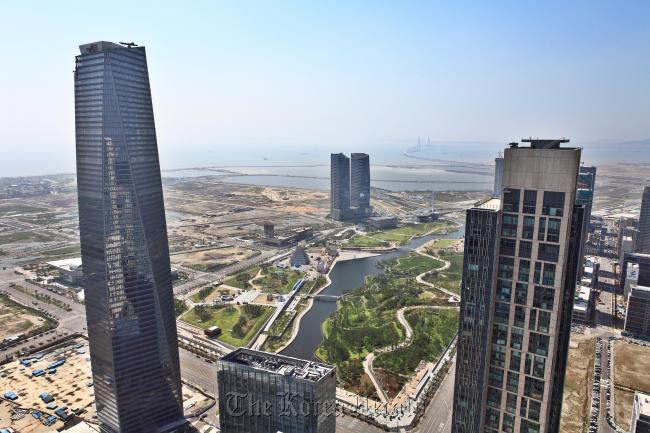Sustainable, green buildings create low-carbon neighborhoods
The following is the fourth in a series of articles on design prepared in anticipation of the Herald Design Forum on Sept. 19-21. ― Ed.
Sustainable development and green businesses have become keywords in various industries, and architecture and city planning are no exception to this trend.
“Sustainability started to be mentioned about 10 years ago and now it is the most important keyword among architects,” said Lim Yeong-hwan, architecture professor of Hongik University and head of the architecture firm DLIM.
But a sustainable big city seems like a contradiction because cities inevitably use a lot of energy, Lim said.
“A scholar once compared it with a hybrid sports utility vehicle. SUVs use more fuel than other types of vehicles, but you make it a hybrid in order to achieve energy reduction. It’s the same for cities,” he explained.
Efforts to create sustainable and green cities continue. As a result, a housing village in England is becoming an inspiration for low carbon neighborhoods, reducing carbon emissions by nearly 50 percent in all aspects of living, especially energy use in the home and transport.
The Beddington Zero Energy Development in England aims for zero carbon emissions in the housing village, using about 45 percent less electricity, 77 percent less heat energy and 58 percent less water.
“Many cities around the world recognize the importance of being sustainable and are trying to transform themselves,” said Lim.
The following is the fourth in a series of articles on design prepared in anticipation of the Herald Design Forum on Sept. 19-21. ― Ed.
Sustainable development and green businesses have become keywords in various industries, and architecture and city planning are no exception to this trend.
“Sustainability started to be mentioned about 10 years ago and now it is the most important keyword among architects,” said Lim Yeong-hwan, architecture professor of Hongik University and head of the architecture firm DLIM.
But a sustainable big city seems like a contradiction because cities inevitably use a lot of energy, Lim said.
“A scholar once compared it with a hybrid sports utility vehicle. SUVs use more fuel than other types of vehicles, but you make it a hybrid in order to achieve energy reduction. It’s the same for cities,” he explained.
Efforts to create sustainable and green cities continue. As a result, a housing village in England is becoming an inspiration for low carbon neighborhoods, reducing carbon emissions by nearly 50 percent in all aspects of living, especially energy use in the home and transport.
The Beddington Zero Energy Development in England aims for zero carbon emissions in the housing village, using about 45 percent less electricity, 77 percent less heat energy and 58 percent less water.
“Many cities around the world recognize the importance of being sustainable and are trying to transform themselves,” said Lim.

The Songdo International Business District, located 65 kilometers west of Seoul, is seen as a model city for sustainable living, where most of the buildings are designed for low energy consumption and built with eco-friendly materials.
“There are many aspects that define sustainable architecture. Green architecture should not only be energy efficient, but should also create harmony with surroundings, use materials that are eco-friendly, and reduce energy in logistics,” Lim said.
Its buildings save and recycle 20 to 45 percent of the water used inside the buildings, and use less electricity.
About 80 percent of the buildings are expected to be certified by the U.S. Green Building Council by 2015. Eight buildings have already been approved so far.
The Songdo Convensia, one of the buildings certified as green, recycles 45 percent of the water used in the building. The convention center also used green building materials extensively for fewer harmful health effects. It saved environmental costs and reduced carbon emissions by ordering building materials available within the country.
To reduce carbon emissions, the city developed an efficient transport transit system and 25 kilometers of bike lanes.
It also collects waste from all parts of the city into one place in order to save carbon emissions from garbage trucks.
“With the world threatened by environmental destruction, The Songdo IBD has been recognized as the city of the future in which technology and environment are well-balanced,” said Stan Gale, chairman of Gale International, the projects main financier.
By Lee Woo-young (wylee@heraldcorp.com)




![[Herald Interview] 'Amid aging population, Korea to invite more young professionals from overseas'](http://res.heraldm.com/phpwas/restmb_idxmake.php?idx=644&simg=/content/image/2024/04/24/20240424050844_0.jpg&u=20240424200058)












![[KH Explains] Korean shipbuilding stocks rally: Real growth or bubble?](http://res.heraldm.com/phpwas/restmb_idxmake.php?idx=652&simg=/content/image/2024/04/25/20240425050656_0.jpg&u=)

